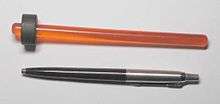Microphonics
Microphonics, microphony, or microphonism[1][2][3] describes the phenomenon wherein certain components in electronic devices transform mechanical vibrations into an undesired electrical signal (noise). The term comes from analogy with a microphone, which is intentionally designed to convert vibrations to electrical signals.

Description
When electronic equipment was built using vacuum tubes, microphonics were often a serious design problem. The charged elements in the vacuum tubes can mechanically vibrate, changing the distance between the elements, producing charge flows in and out of the tube in a manner identical to a capacitor microphone. A system sufficiently susceptible to microphonics could experience audio feedback, and make noises if jarred or bumped. To minimize these effects, some vacuum tubes were made with thicker internal insulating plates and more supports,[4] and tube-socket assemblies were sometimes shock-mounted by means of small rubber grommets placed in the screw holes to isolate them from vibration.[2]

A special tool, called a valve hammer, or tube hammer was sometimes used to safely tap the device suspected of being microphonic, while it was operating, so checking if such a tap would produce objectional audio effects.[1]
Microwave tube designers took numerous steps to reduce microphonics in klystrons. Where tuning was essential, a compromise usually was made between the resistance of the klystron to microphonism and the obtainable performance.[3]
With the advent of solid-state electronics (transistors), this major source of microphonics was eliminated but smaller sources still remain.
The ceramic EIA Class 2 dielectrics used in high-K capacitors ("Z5U" and "X7R") are piezoelectric and directly transform mechanical vibration into a voltage in exactly the same way as a ceramic or piezoelectric microphone.[5] Film capacitors using soft (mechanically compliant) dielectric materials can also be microphonic due to vibrational energy physically moving the plates of the capacitor. Likewise, variable capacitors using air as a dielectric are vulnerable to vibrations moving the plates. Capacitors using glass as the dielectric, while quite expensive, can be made to be essentially nonmicrophonic.
Wiring, cables and even PCBs can also exhibit microphonics as charged conductors move around, and various materials can develop triboelectric ("static") charges that couple to the electronic circuits.
Guitar amplifiers that incorporate the electronic chassis into the same cabinet as the speaker are susceptible to microphonics. Though a guitar amplifier's microphonics distortion is sometimes appreciated as part of the "special sound" of a guitar amplifier, a faulty vacuum tube or other component can cause out-of-control positive feedback. Unwanted microphonics-related audible distortions can often be alleviated by using commercially available vacuum tube mechanical dampers.
The term may also be used to describe a video artifact common in older video cameras. Before the introduction of solid-state CCD sensors to produce the image, vacuum tubes performed this task. Loud noises in the studio, such as rock bands or gunshot effects would cause the tubes to vibrate, producing a characteristic undesirable horizontal banding in the image.[6]
The effect can also be observed when operating a vinyl record player in the same room as the loudspeakers. Depending on the construction of the player the sound may acoustically couple into the record player's dust cover or other mechanical parts and cause a feedback loop into the pickup cartridge.
Many in-ear-canal headphones exhibit microphonics when headphone cables transfer vibrations due to cable movement directly to the wearers ears.[7]
See also
- Audio spill
- Cable grommet
- Crosstalk
- Ringing (signal)
References
- Valkó, Iván Péter (1956). Acta Technica - Academiae Scientiarum Hungaricae. 15. Budapest, Hungaria: Magyar Tudományos Akadémia. pp. 229–231. Retrieved 2013-04-17.
- Korn, Granino Arthur; Korn, Theresa M. (1956). Electronic analog computers (d-c analog computers) (2 ed.). McGraw-Hill. pp. 157, 248–249. Retrieved 2013-04-17.
- La Plante, Roger A. (July 1956). "Nonmicrophonic Klystron". Electronics. 29. Philips Laboratories, Irvington-on-Hudson, NY, USA: McGraw-Hill Publishing Company. pp. 238, 241. Retrieved 2013-04-17.
- Tomer, Robert B. (July 1960). "Chapter 3: Subjective Failures: Microphonics". Getting the most out of Vacuum Tubes (PDF). Photofact Publication (first printing, first ed.). Indianapolis, USA: Howard W. Sams & Co., Inc. pp. 48–50. LCCN 60-13843. VTT-1. Archived (PDF) from the original on 2019-07-15. Retrieved 2020-01-31.
- Laps, Mark; Grace, Roy; Sloka, Bill; Prymak, John; Xu, Xilin; Pinceloup, Pascal; Gurav, Abhijit; Randall, Michael; Lessner, Philip; Tajuddin, Aziz (March 2007). "Capacitors for Reduced Microphonics and Sound Emission" (PDF). CARTS 2007 Symposium Proceedings. Albuquerque, NM, USA: KEMET Electronics Corporation, Electronic Components, Assemblies & Materials Association (ECA), Arlington, VA. Archived (PDF) from the original on 2019-11-16. Retrieved 2020-01-31. (8 pages)
- Demtschyna, Michael (2002). "Video Artefacts - Microphony". Michael D's DVD. Archived from the original on 2019-06-11. Retrieved 2020-01-31.
- Frakes, Dan (2007-01-31). "In-ear-canal headphone primer". Macworld. Headsets. IDG. Archived from the original on 2019-03-28. Retrieved 2020-01-31.